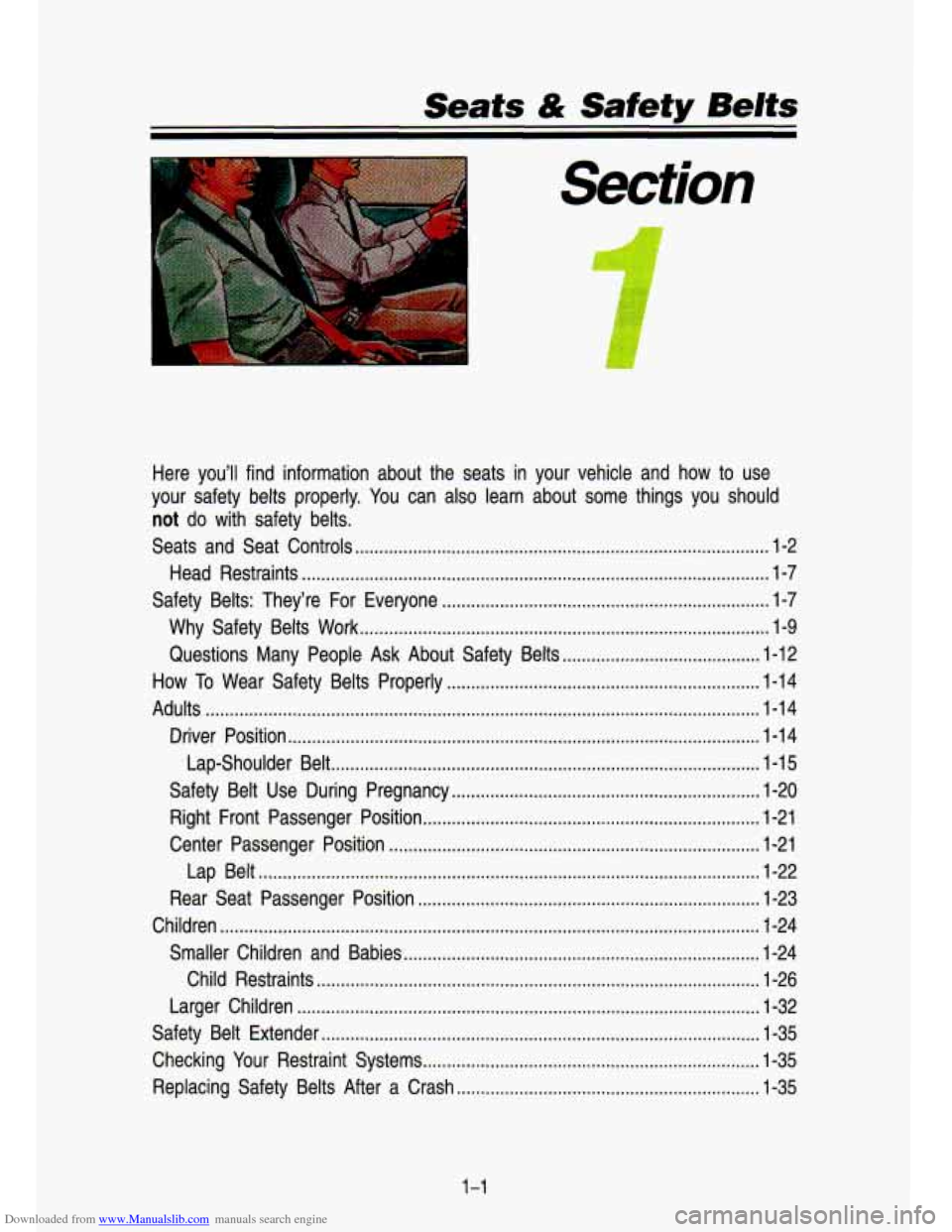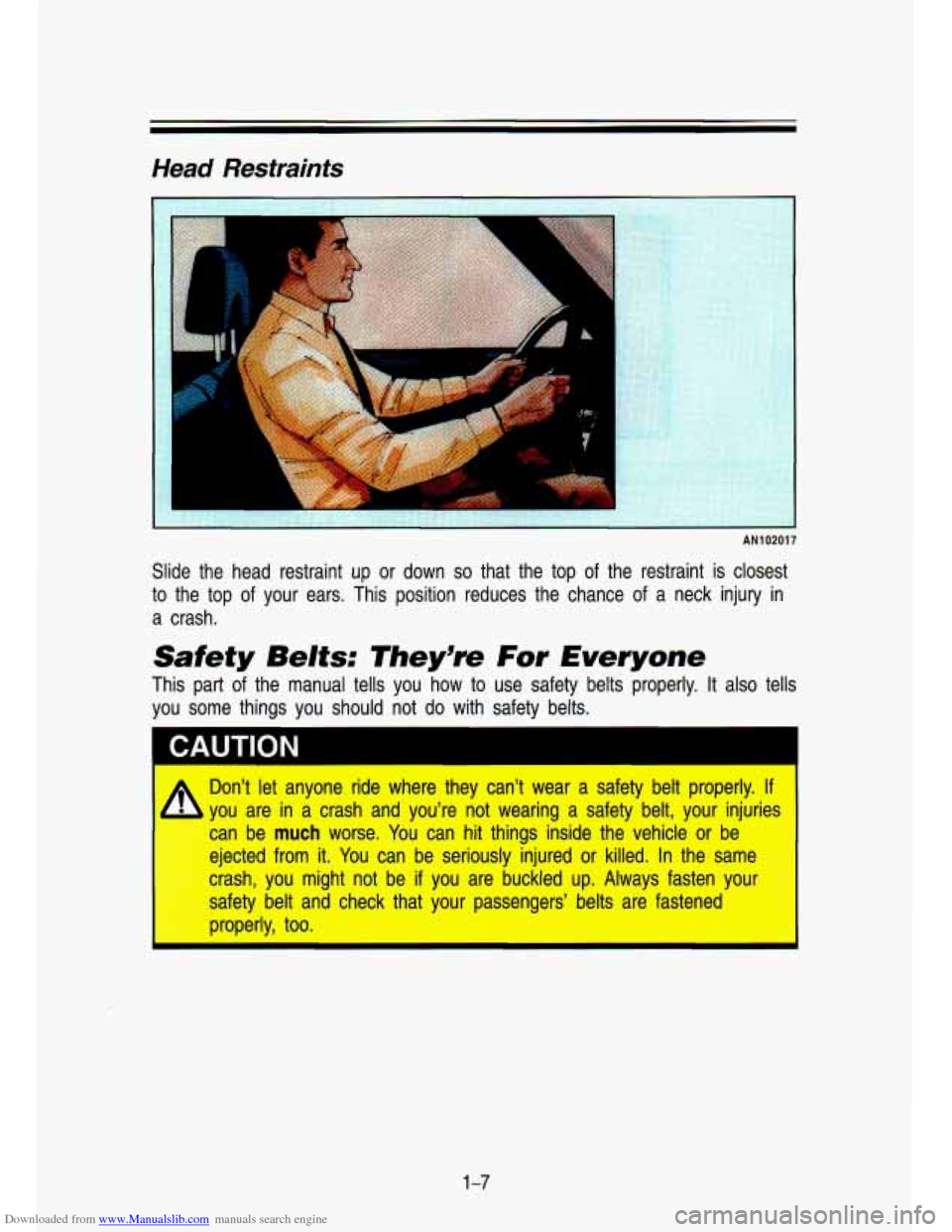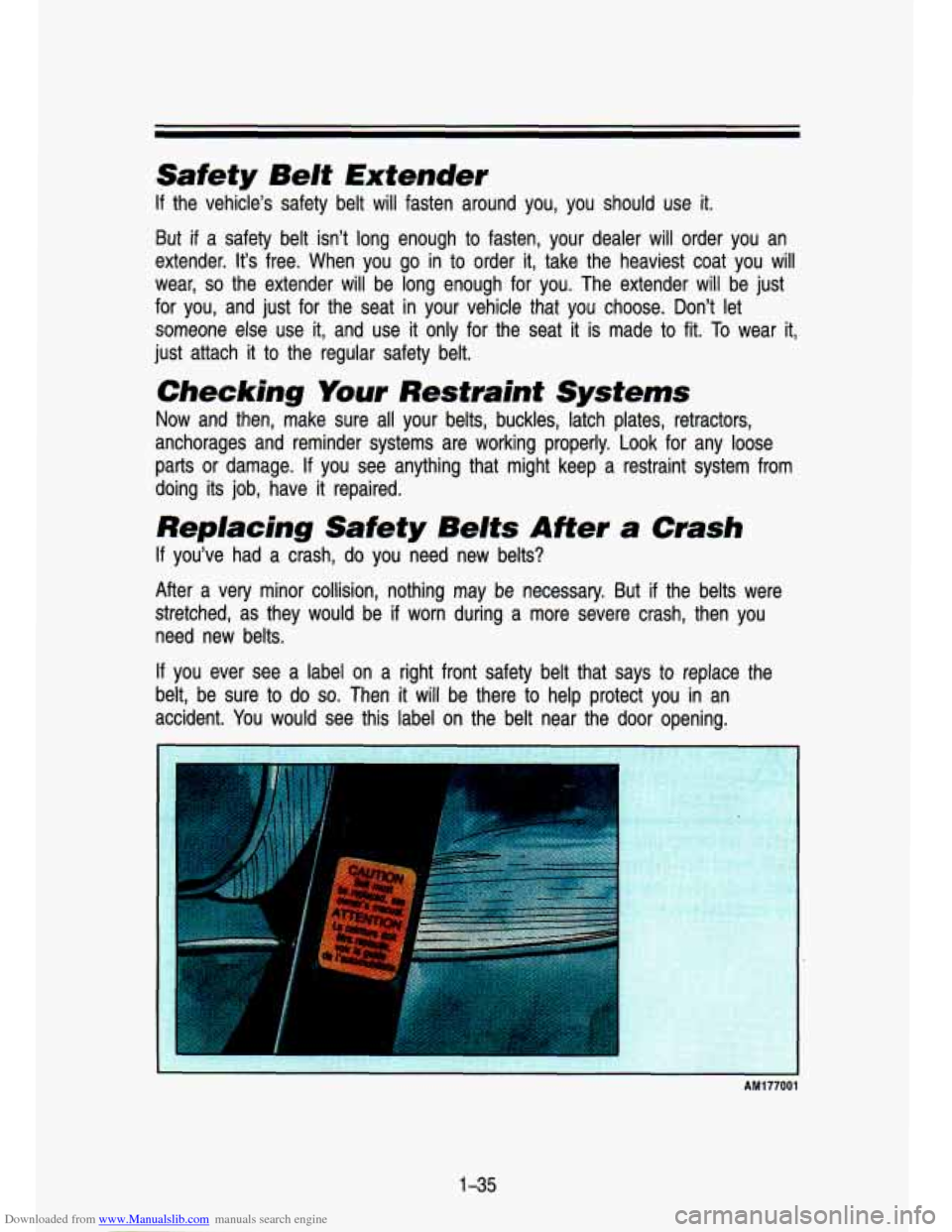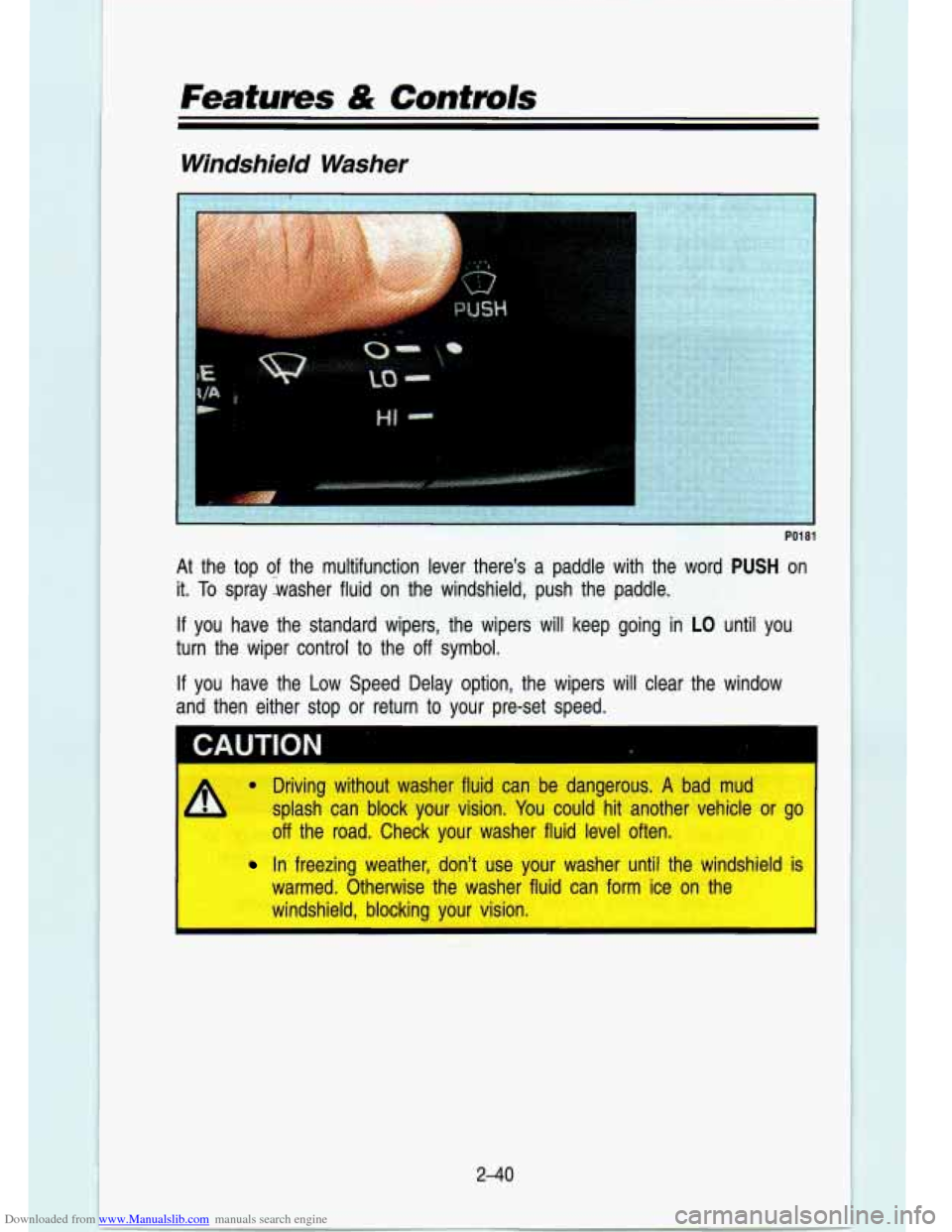1993 CHEVROLET S10 check engine
[x] Cancel search: check enginePage 15 of 356

Downloaded from www.Manualslib.com manuals search engine Seats & Safety Belts
.
Section
Here you’ll find information about the seats in your vehicle and how to use
your safety belts properly
. You can also learn about some things you should
not do with safety belts .
Seats and Seat Controls ........................................................................\
.............. 1-2
Head Restraints
........................................................................\
......................... 1-7
Safety Belts: They’re For Everyone .................................................................... 1-7
Why Safety Belts Work ........................................................................\
............. 1-9
Questions Many People Ask About Safety Belts ......................................... 1-12
How
To Wear Safety Belts Properly ................................................................. 1-14
Adults
........................................................................\
........................................... 1-14
Driver Position
....................................... ........I .................................................. 1-14
Lap-Shoulder Belt
........................................................................\
................. 1-15
Safety Belt Use During Pregnancy
................................................................ 1-20
Right Front Passenger Position
...................................................................... 1-21
Center Passenger Position
........................................................................\
..... 1-21
Lap Belt ........................................................................\
................................ 1-22
Rear Seat Passenger
f ;ition ....................................................................... \
1-23
Children
........... ..... ~I ........................................................................\
....................... 1-24
Smaller Children and Babies
........................................................................\
.. 1-24
Child Restraints
........................................................................\
.................... 1-26
Larger Children ........................................................................\
........................ 1-32
Safety Belt Extender
........................................................................\
................... 1-35
Checking Your Restraint Systems
...................................................................... 1-35
Replacing Safety Belts After a Crash
................................... e ........................... 1-35
1-1
Page 21 of 356

Downloaded from www.Manualslib.com manuals search engine Head Restraints
h
b
AN1 Oru I i
Slide the head restraint up or down so that the top of the restraint is closest
to the top of your ears. This position reduces the chance of a neck injury in
a crash.
Safety Belts: They9re For Everyone
This part of the manual tells you how to use safety belts properly. It also tells
you some things you should not
do with safety belts.
CAUTION
A
Don’t let anyone ride where they can’t wear a safety bel\
t properly. If
you are in a crash and you’re not wearing a safety belt, your injuries\
can be
much worse. You can hit things inside the vehicle or be
ejected from it. You can be seriously injured or killed. In the same
crash, you might not be
if you are buckled up. Always fasten your
safety belt and check that your passenaers’ belts are fasten\
ed properly, too.
1-7
Page 49 of 356

Downloaded from www.Manualslib.com manuals search engine Safety Belt Extender
If the vehicle’s safety belt will fasten around you, you should\
use it.
But if a safety belt isn’t long enough to fasten, your dealer will o\
rder you an
extender. It’s free. When you go in to order it, take the heaviest coat you will
wear,
so the extender will be long enough for you. The extender will b\
e just
for you, and just for the seat in your vehicle that you choose. Don’t let
someone else use it, and use it only for the seat it is made to fit. To wear it,
just attach it to the regular safety belt.
Checking Your Restraint Systems
Now and then, make sure all your belts, buckles, latch plates,\
retractors,
anchorages and reminder systems are working properly. Look for \
any loose
parts or damage.
If you see anything that might keep a restraint system from
doing its job, have it repaired.
Replacing Safety Belts After a Crash
If you’ve had a crash, do you need new belts?
After a very minor collision, nothing may be necessary. But if\
the belts were
stretched, as they would be if worn during
a more severe crash, then you
need new belts.
If you ever see a label on a right front safety belt that says \
to replace the
belt, be sure to
do so. Then it will be there to help protect you in an
accident. You would see this label on the belt near the door opening.
1-35
AM177001
Page 80 of 356

Downloaded from www.Manualslib.com manuals search engine Features & Controls
Manual Transfer Case
I
PO1 63
The transfer case shift lever is on the floor to the right of the driver. Use this
lever
to shift into and out of four-wheel drive. An indicator light near the lever
shows you the transfer case settings:
2 WHEEL
4 HIGH
N SET PARKING BRAKE
4 LOW
The front axle portion
of the diagram on the indicator will light up when you
shift into four-wheel drive. A slight delay between shifting and the patte\
rn's
lighting is normal.
If the pattern does not light up, or if the front axle does
not go out after you shift out
of four-wheel drive, have your dealer check
your system. Turn the dial above your headlight switch
to the left to dim your
transfer case indicator light when your headlights or parking l\
ights are on.
2 WHEEL: This setting is for driving in most street and highway situations.
Your front axle is not engaged in two-wheel drive.
4 HIGH: This setting engages your front axle to help drive your vehicle.
Use
4 HIGH when you need extra traction, such as on snowy or icy roads, \
or in most off-road situations.
N SET PARKING BRAKE: Shift to this neutral setting only when your vehicle
needs
to be towed.
2-28
I
Page 89 of 356

Downloaded from www.Manualslib.com manuals search engine To signal a lane change, just raise or lower the lever until the green ar\
row
starts to
flash. Hold it there until you complete your lane change. The lever
will return by itself when you release it.
As you signal a turn or a lane chi' -- if the arrows don’t flash but just stay
on, a signal bulb may be burned
OUT and other drivers won’t see your turn
signal.
(If your vehicle has the digital instrument cluster, the turn signa\
l arrows will
flash at a faster rate
if a signal bulb is burned out.)
If a bulb is burned out, replace it to help avoid an accident. If the green
arrows don’t go on at all when you signal a turn, check the fuse (see
“Fuses” in the Index) and for burned-out bulbs.
If you have a trailer towing option with added wiring for the tr\
ailer lights, a
different turn signal flasher is used. With this flasher instal\
led, the signal indicator will flash even if a turn signal bulb is burned out\
. Check the front
and rear turn signal lights regularly to make sure they are working.
Operation of Lights
Although your vehicle’s lighting system (headlights, parking \
lights, fog lamps,
side marker lights and tail lights) meet all applicable Federa\
l lighting
requirements, certain states and providences may apply their own\
lighting
regulations that may require special attention before you operat\
e these lights. For example, some jurisdictions may require that you operate yo\
ur lower
beam lights with fog lamps at all times, or that headlights b\
e turned on
whenever you must use your windshield wipers. In addition, most\
jurisdictions
prohibit driving solely with parking lights, especially at dawn \
or dusk.
It is
recommended that you check with your own state or provincial h\
ighway
authority for applicable lighting regulations.
2-37
Page 92 of 356

Downloaded from www.Manualslib.com manuals search engine Features & Controls
Windshield Washer
POT81
At the top of the multifunction lever there's a paddle with the word PUSH on
it. To spray 'hasher fluid on the windshield, push the paddle.
If you have the standard wipers, the wipers will keep going in LO until you
turn the wiper control to the off symbol.
If you have the Low Speed Delay option, the wipers will clear th\
e window
and then either stop
or return to your pre-set speed.
Driving without washer fluid can be dangerous. A bad mud
off the road. Check your washer fluid level often.
warmed. Otherwise the washer fluid can form ice on the
windshield, blocking your vision.
1 splash can block your vision. You could hit another vehicle or go I
In freezing weather, don't use your washer until the windshield is\
2-40
Page 99 of 356

Downloaded from www.Manualslib.com manuals search engine Push the switch marked OFF to turn off your lights.
Turn the dial above the headlight switch to the right to make your instrument
panel and transfer case lights brighter. Turning the dial all the way to the
right until it clicks will turn on the interior lights.
Turn the dial to the left to dim your instrument panel and transfer case
indicator lights.
You can switch your headlights from high to low beam by pulling on the
multifunction lever.
A circuit breaker protects your headlights. If you have an electrical overload,
your headlights will flicker on and
off. Have your headlight wiring checked
right away
if this happens.
Fog Lamps
KO940
Use your optional fog lamps for better vision in foggy or misty conditions.
Your parking lights and/or low beam headlights must be on or your lamps
won’t work.
The fog lamp switch is on the instrument panel under the headlight switch.
Press the right side of the switch to turn the fog lamps on, and the left side
of the switch to turn them
off. A light will glow in the right side of the switch
when they are on.
2-47
Page 104 of 356

Downloaded from www.Manualslib.com manuals search engine Features & Controls
k If you aren't used to a convex mirror, you can hit another vehicle. A
- convex mirror can make things (like other vehicles) look farther away c
than they really are. If you cut too sharply into the right lane, you
could hit a vehicle on1 your right. Check your inside mirror or gla.nce L
over your shoulder before changinig lanes.
Sun VisorsNanify Mirrors
KO251
To block out glare, you can swing down the visors. You can also swing them
from side to side.
Some visors have mirrors built in, with and without lights. Ju\
st lift the mirror
cover on each visor to turn the lights on
if you have them.
2-52
1